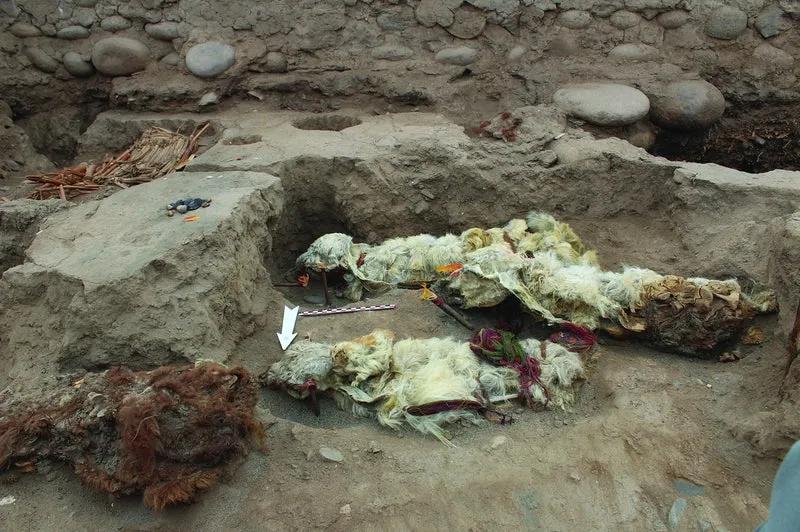Sacrificed Llamas Found in Peru Were Likely a Gift From the Inca
The elaborately decorated animals were probably buried alive alongside similarly adorned guinea pigs
:focal(652x286:653x287)/https://tf-cmsv2-smithsonianmag-media.s3.amazonaws.com/filer/60/1c/601c87ae-bfad-4dfe-bccf-58332529563f/llama_1280p.jpg)
Four well-preserved llamas killed in South America more than 500 years ago hold clues to the religious and political practices of the Inca Empire, new research suggests.
As Alexandra Topping reports for the Guardian, archaeologists who studied the naturally mummified llamas and their surroundings think the animals were sacrificed as part of a display of generosity to another group of people who had just joined the empire. The findings are newly published in the journal Antiquity.
Per the paper, Inca people adorned the llamas with valuable materials before burying them alive alongside similarly decorated guinea pigs. Other artifacts found at the site, including large ovens, indicate that the sacrifice was part of a big celebration.
“The offerings likely were part of much larger feasts and gatherings, sponsored by the state,” says lead author Lidio Valdez, an archaeologist at the University of Calgary, in a statement. “The state befriended the local people with food and drink, cementing political alliances, whilst placing offerings allowed the Inca to claim the land as theirs.”
Archaeologists began excavating the site, an Inca administrative center in Tambo Viejo, Peru, in 2018. They learned that an important road from the Nazca Valley on Peru’s southern coast stopped at Tambo Viejo, in addition to discovering architectural features including a large plaza and a religious structure.
Per Science magazine’s Michael Price, radiocarbon dating of the llamas, which were naturally mummified by the dry air, suggests they were killed between 1432 and 1459—a time of expansion for the empire. Before about 1430, the Inca were concentrated in the area around the capital city of Cusco in the Peruvian Andes. After that, the civilization expanded, both peacefully and sometimes through violence, into a larger territory. Spanish colonial accounts report that the Inca peacefully annexed the Acari Valley, where Tambo Viejo is located, around the time the sacrifice took place.

This isn’t the first recorded instance of Inca llama sacrifice, writes Garry Shaw for the Art Newspaper. Previously, however, researchers had only found the sacrificed creatures’ bones.
The valuable animals were second only to humans as gifts to the deities. Spanish accounts describe rituals in which Inca sacrificed 100 or more llamas at a time.
“Gifts could not be just anything, but something valuable to the Incas themselves,” Valdez tells the Art Newspaper. “So, llamas were one of the valuable items they had.”
The new findings show that the mummified llamas were heavily decorated with colorful strings; their faces were painted with red lines. The site of the sacrifice also contained the orange feathers of tropical birds and black lima beans.
“This is the first of its kind. There is nothing comparable,” Valdez tells Gizmodo’s George Dvorsky. “Now we know that Inca animal offerings were highly adorned.”
Three of the llamas were white, and one was brown. The researchers also found a fifth llama, but it was badly degraded. Prior research suggests that the Inca sacrificed brown llamas to the creator god Viracocha and white ones to the sun deity Inti, the most important god in the Inca pantheon, per the Guardian.
“The finding adds important information about Inca ideology, something about which we knew from the writings of some early Spaniards, but never saw,” Valdez tells the Art Newspaper. “Now we have the tangible evidence.”
/https://tf-cmsv2-smithsonianmag-media.s3.amazonaws.com/accounts/headshot/Livia_lg_thumbnail.png)
/https://tf-cmsv2-smithsonianmag-media.s3.amazonaws.com/accounts/headshot/Livia_lg_thumbnail.png)